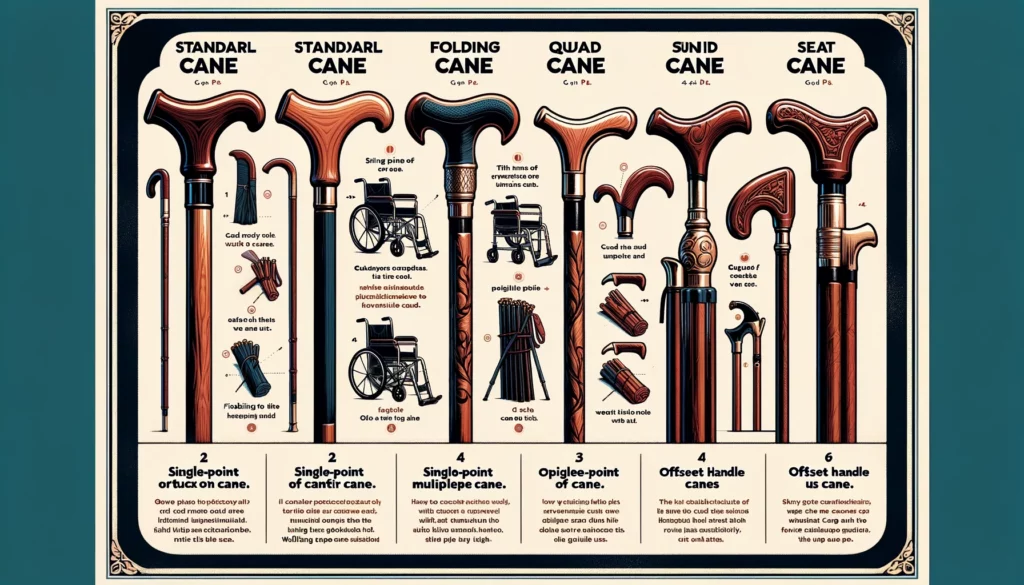Different Types of Walking Canes – A Guide to Choosing the Right One!
Walking canes are an important mobility aid for many people. They provide increased stability and support, helping users maintain balance and prevent falls. With various types of canes available, it’s important to understand the options to find the right one for your needs. This guide covers the basics of choosing and using walking canes properly.
What is Walking Canes?
Walking canes have been used throughout history as a functional tool and a fashion accessory. Today, canes are often used by people with injuries, medical conditions like arthritis, or balance issues to improve stability and confidence when walking.

With options ranging from simple single-tip canes to quad canes with four points, there is a perfect cane for every situation. Learning about the different types of canes and how to use a cane correctly empowers users to find the ideal mobility solution.
Understanding the Basics of Walking Canes
A walking cane, also known as a walking stick, is a device used to improve balance, stability, and support when walking. Walking canes distribute the user’s weight across a wider base to make walking easier and safer.
The shaft of a walking cane is designed to comfortably bear the user’s weight while the handle allows for an ergonomic grip. The tip makes contact with the ground for balance. Canes are typically made of wood, aluminum, or composites.

Walking canes have been utilized throughout history dating back to ancient Egypt. They have served various purposes beyond supporting mobility including indicating social status and for self-defense.
Today, the primary use of a cane is to aid in walking and prevent injuries from falls. Various health professionals may prescribe canes such as physicians, and physical or occupational therapists.
Different Types of Walking Canes

Standard Canes:
The standard cane is the most common design featuring a single shaft with a curved or straight handle. These versatile walking canes are often made of lightweight aluminum making them easy to maneuver. Standard canes are inexpensive and their simple design means they are easy to replace.
- Features: Single shaft, can have a curved or straight handle.
- Benefits: Lightweight, versatile, and generally inexpensive. Ideal for those who need minimal support
Offset Canes:
Offset canes have a handle that is positioned at an angle. This design feature helps relieve wrist strain which makes these canes ideal for people with arthritis or other wrist and grip issues. The angled handle on offset canes also makes them easier to grip securely.
Common Features and Benefits:
- The offset handle is positioned at an angle.
- Designed to relieve wrist strain.
- Better for people with arthritis or wrist injuries.
- Offers more ergonomic support.
Quad Canes:
Quad or four-pronged canes have four feet at the base for additional stability. The wider base provides a larger area of support by distributing the user’s weight across four points. These walking sticks prevent slipping and are good for those with substantial balance issues.
Common Features and Benefits:
- Characterized by 4 feet at the base.
- Provides extra stability, especially on uneven surfaces.
- Good for balance issues.
- Suitable for those requiring substantial support.
Folding Canes:
Folding canes collapse inward, making them more convenient for traveling and storage. Most folding canes have a built-in seat perfect for use on buses, sports events, or other scenarios where sitting is periodically required.
Common Features and Benefits:
- Cane handle collapse for portability.
- Ideal for travel and easy storage.
- Often lightweight and adjustable.
- Some models come with built-in seats for resting.
Seat Canes:
Seat canes provide dual functionality. They have the typical designs of a standard walking cane but with a seat attached at the top under the handle. The seats flip down for periodic rest during long treks.
Common Features and Benefits:
- Dual functionality: a walking aid and a portable seat.
- Useful for users who need to take frequent breaks.
- Offers a convenient resting option.
Single-Point vs Multiple-Point Canes:
Single-tip canes like standard and offset canes rely on just one point touching the ground. In contrast, multi-point canes like quad canes have more than one point making contact for enhanced stability. The choice depends on the user’s balance and support needs.
Common Features and Benefits:
- Single-point canes: Standard design, one contact point with the ground.
- Multiple-point canes (like quad canes): Increased stability with multiple ground contact points.
Key Considerations When Selecting a Cane

- Intended Use: Determining the intended purpose of the walking cane is crucial. Typical uses include medical needs like improving stability for injuries/conditions, boosting balance for mobility issues, or general lightweight support for activities. Defining the needs upfront ensures finding the right option.
- Material: Canes come in aluminum, steel, or wood models. Aluminum walking canes are the lightest while wooden options provide more classic styling. Materials impact the cane’s durability and weight so consider tradeoffs. Steel adds sturdiness but increases weight for example.
- Handle Style: The handle should enable a comfortable, secure grip. Basic crook handles or ergonomic styles that contour to the hand both facilitate easy grasping. An incorrectly sized or uncomfortable handle makes utilizing a cane difficult. Determine the most appropriate style based on the user’s needs and hand size.
- Height: The proper cane height helps provide optimal support. The industry standard is selecting a cane so the top contours to the crease of the user’s wrist when the arm is relaxed at the side. Some companies offer custom height adjustments as needed.
- Weight Capacity: Canes have weight limits based on materials and construction. Selecting a cane that meets or exceeds the user’s needs for weight bearing ensures the stability and integrity of the device. Too much weight stresses the shaft and risks breakage or instability.
How to Properly Use and Maintain Your Cane
Using and caring for your walking cane properly ensures you get optimal stability and longevity from your mobility device. Follow these tips for ideal usage.
Correct Way to Hold and Use a Cane
- Hold the cane in the hand opposite your injury or instability. This allows the cane to support the weaker side.
- Keep your elbow slightly bent when holding the grip. A straight arm hinders natural walking flow.
- All four points of a quad cane should maintain contact with the ground while stepping for maximum stability.
- Place the cane about 6 inches away from the toes, opposite the weakened leg. Step forward with the cane and affected leg simultaneously.
- Press into the ground when stepping for extra support. Don’t just rest the cane tips against the floor.
Maintenance Tips for Different Types of Canes
- Monitor rubber tips and replace them if excessively worn for slip resistance.
- Periodically tighten any loose screws or connections on adjustable canes to prevent instability.
- Use furniture polish/cleaners and soft cloths to maintain the shine on wooden canes. Avoid moisture buildup.
- Store **folding canes **in an open, unfolded position to improve the lifespan of folding joints.
Safety Precautions and Tips
- Don’t overload a cane beyond its weight capacity to prevent breakage.
- Customize the cane height for optimal wrist support and control.
- Exercise additional caution on wet, icy, or uneven terrain which increases slipping risk.
At End
Selecting the proper walking cane is an important decision that requires carefully evaluating your needs in terms of support, balance, health conditions, and intended use. With options ranging from simple, single-tip canes to more stable quad canes, take the time to determine the best match. Consider weight capacity, material, handle design, and proper sizing during your search.
While a cane can provide tremendous assistance with mobility, be sure to follow usage tips like proper hand placement and weight distribution for maximum benefits. Maintain your cane well with cleaning and upkeep checks tailored to the type of device. Following recommendations from health professionals such as a physician or physical therapist can further ensure an appropriate walking cane selection.
Investing in this vital mobility aid means regaining confidence to navigate your daily activities with stability. Considering needs upfront when deciding among the various types of canes allows you to find a device that securely fits into your lifestyle needs. They can guide you in choosing the right cane, ensuring it provides the support you need while fitting comfortably in the palm of your hand.

Muhammad Asif Saeed, a seasoned professional in commerce and finance, holds a Bachelor of Commerce degree specializing in Accounts and Finance, complemented by an MBA with a focus on Marketing. With an impressive 20-year career in Pakistan’s textile sector, including roles at Masood Textile (MTM) and Sadaqat Limited, he excels in business and financial management.
Muhammad Asif Saeed is also a recognized authority in the field, contributing authoritative articles to renowned websites such as businessproplanner.com, businessprotips.com, distinctionbetween.com, trueqube.com, and bruitly.com. His insightful perspectives on complex finance and business operation topics underscore his comprehensive knowledge and professional expertise.







